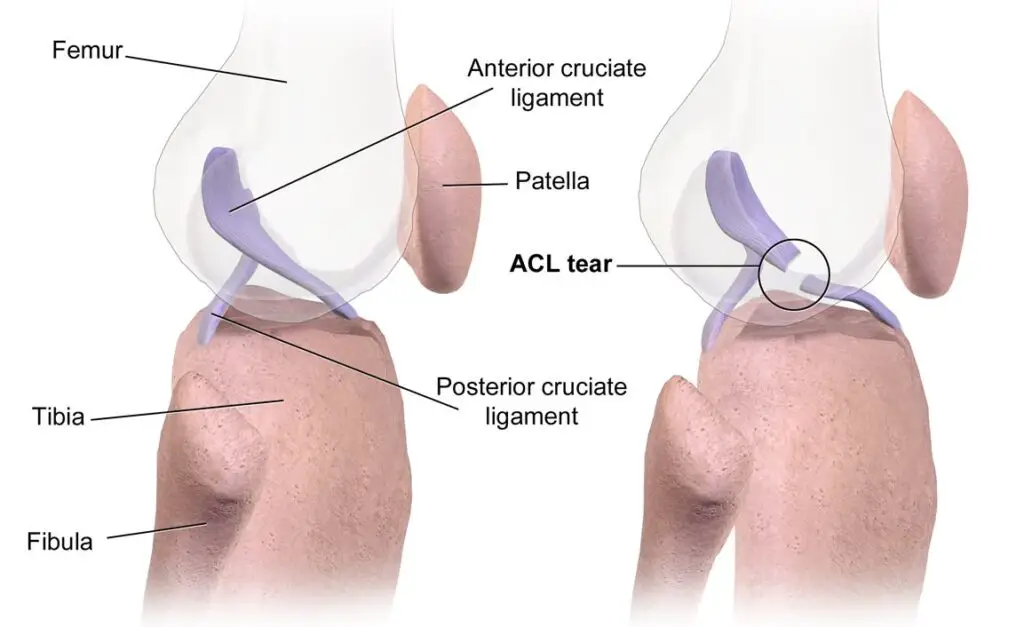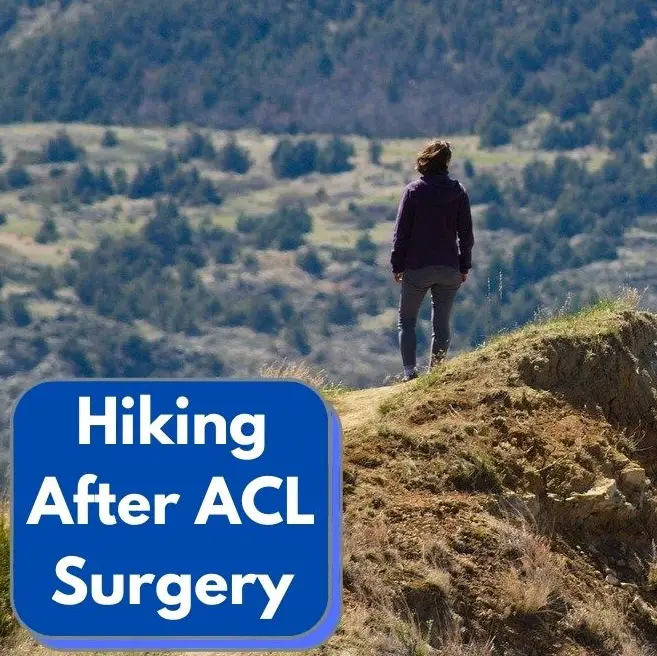ACL injuries are common with activities that require extensive lower body movement such as sports and especially hiking. If you’ve had ACL reconstruction you’re probably wondering if hiking after ACL surgery is possible and how soon you can get back on the trail.
You can plan to go hiking after ACL surgery in about 6 months, depending on the severity of the injury, your overall fitness level, and how strict and rigorous your physical rehab program is.
How Soon Can I Go Hiking After ACL Surgery?
The question most folks ask after their operation is “how soon can I hike after ACL surgery?”.
There are a lot of variables, but the general rule of thumb is about 6 months as long as you follow your rehab instructions and get clearance from your doctor.
Six months is the general amount of time that it takes for your ACL surgery to heal and for your knee joint and surrounding muscles to regain their proper strength to safely support you while hiking.
How Do People Injure Their ACL When Hiking?

To understand why hikers often experience ACL injuries, we first need to understand what the ACL is.
What’s An ACL?
Your ACL (short for anterior cruciate ligament) is a strong band of tissue that helps connect your thigh bone (aka femur) to your shin bone (aka tibia).
How Do ACL Injuries Occur?
ACL injuries occur during activities that involve sudden stops or changes in direction and may involve jumping or landing as well.
When hiking up or down steep slopes you may experience sudden changes in direction and abrupt stops, especially on loose terrain or while scrambling over large obstacles, so it’s understandable how ACL injuries can occur while on the hiking trail.
How Can I Tell If I Injured My ACL While Hiking?
Most people feel a popping sensation in their knee or may even hear an audible “pop” when the ACL injury happens.
You may also experience knee swelling and may not be able to bear weight on the leg with the damaged ACL.
Hiking With Torn ACL – Should You Do It?
Although you can walk on a torn ACL after the pain and swelling subsides, most professionals will advise you not to go hiking with a torn ACL under any circumstances.
Your ACL provides stability to your knee and hiking involves turning, twisting, and pivoting using your knees, and there is no way to hike without doing at least some of these movements.
Hiking with a torn ACL or hiking with an ACL injury could put you at further risk of greater injury, and that’s simply not worth it.
How To Go Hiking After ACL Reconstruction
Follow these steps to get back on the trail as quickly as possible after going through your ACL surgery.
Step 1: Follow And Complete Your Rehabilitation And Physical Therapy Programs
Post-surgical physical therapy is usually divided into a few categories over 6 months:
- Weeks 1-4: Icing and elevating the knee to keep swelling down, multidirectional strengthening of the patella (knee cap), and exercising the quads, hamstrings, and calf muscles.
- Weeks 5-9: Reduce dependency on using crutches, start tonification exercises.
- Weeks 10-12: Exercising the knee laterally (side-to-side) as well as forward and backward.
- Weeks 13-16: Addition of walking, jogging, and jumping
- Weeks 17-30: Return to non-competitive sporting activities with a focus on building up knee strength, control over movement, and endurance.
Note that your physical therapy routine may differ from the general one outlined above.
You should always follow your own personal plan as dictated to you by a professional.
Step 2: Get The Go-Ahead From A Professional
Consult with your doctor to get cleared to start hiking or resuming other physical activity – this is not something you want to jump into if your body isn’t ready, so make sure to get things checkout out before going full steam ahead.
Step 3: Start With Simple Hikes
If you’re an experienced hiker this may be frustrating, but you’ll need to start off doing very straightforward hikes on flat ground and for shorter lengths than you may be used to.
Choose flat trails (paved if possible) and be mindful to not twist your knee as you walk so you don’t reinjure anything.
Step 4: Gradually Increase The Difficulty Of Your Hikes
Build up the length and difficulty of your hikes over time, but still be cautious about hiking trails with slippery surfaces like mud, or hiking up hilly trails that have lots of scree.
Step 5: Keep Your Muscles And Joints In Shape
Now that you’re back to regular hiking after ACL surgery you need to take proper care of your muscles and joints to keep them strong and prevent future problems from popping up on you.
Check out our guides on how to prepare knees for hiking, exercises to give you explosive power for hiking uphill, and how to train for hiking on a treadmill for some helpful tips.
Step 6: Consider Compression Wear For Hiking
Compression sleeves and compression pants for hiking are good ways to reduce swelling and keep things “in their place” as you hike, preventing future injuries or exacerbating any complications after your ACL surgery.
Compression clothing has also been shown to quicken recovery time and reduce muscle soreness after physical activity, so this is a win-win in our book.
How To Prevent Hiking ACL Injuries

If you’ve torn or otherwise injured your ACL while hiking then we don’t need to tell you why taking active steps to prevent it is important!
If you’ve been lucky enough to avoid an ACL injury from hiking so far, then good for you for looking at prevention tips.
Follow these methods to reduce your likelihood of suffering an ACL injury from hiking.
Avoid Heavy Packs
Try to reduce your pack load as much as possible – every ounce adds up and the heavier your backpack is, the more stress you’re putting on your lower body joints.
Shave off pack weight wherever you can and find the best way to carry water while hiking to keep the strain off your pack.
Consider using a hiking fanny pack to reduce the amount of gear you’re hauling around.
Use Hiking Poles
Hiking poles help shift the weight off your lower body and help to stabilize your knees on downhill slopes to add extra balance.
Make sure you read our guide on how to size hiking poles to get the best fit.
Consider Lighter Hiking Footwear
Although hiking boots are great, there are alternate options that aren’t quite as heavy that will still provide excellent traction like minimalist hiking shoes and trail runners.
If you still like the cut and feel of hiking boots, check out barefoot hiking boots since they’re usually much more lightweight than regular hiking boots.
Reduce Body Weight If Possible
The total mass of your body weight impacts all of your joints – including your knees.
Fortunately, hiking is both an aerobic and anaerobic workout and hiking is also a great way to burn fat, so the more you hike the easier it will be to reduce your weight if that is something you’re interested in.
A Special Note For Hikers With Flat Feet
If you have flat feet and you’re not hiking with the right kind of footwear, you’re placing additional strain on your lower body (like your knees) that can affect your ACL over time.
Check out our guide to the best hiking boots for flat feet for men and women for some good suggestions.
Hiking After ACL Surgery: Wrapping Things Up
Fortunately, hiking after ACL reconstruction is possible as long as you take your physical therapy regimen seriously.
We also covered some easy ways to prevent future ACL injuries from hiking to keep you out of trouble.
Have you experienced a torn ACL or other ACL injury from hiking? How long did it take you to get back to hiking after ACL reconstruction?
Let us know in the comments below!

